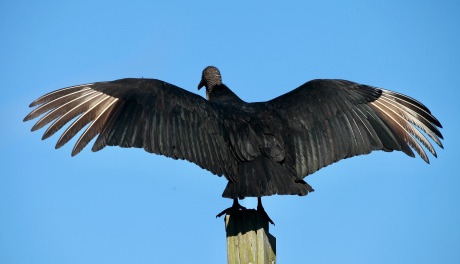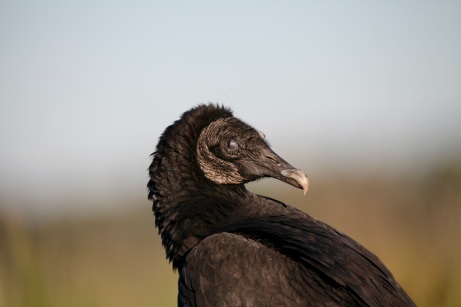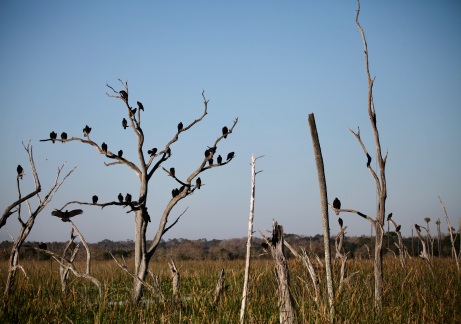 This Black Vulture above, at Merritt Island NWR Nature Center, appeared to be drying off his feathers in the manner of Cormorants and Anhingas. Another visitor said he’d seen the bird emerge from the water just beforehand – a behavior I have never observed, though Black Vultures are very common here in Florida.
This Black Vulture above, at Merritt Island NWR Nature Center, appeared to be drying off his feathers in the manner of Cormorants and Anhingas. Another visitor said he’d seen the bird emerge from the water just beforehand – a behavior I have never observed, though Black Vultures are very common here in Florida.  But the Vulture behavior that really puzzled us was what we later saw at nearby Orlando Wetlands. We were literally surrounded by hundreds of Black Vultures – they were simply EVERYWHERE!! In the trees, on the ground, underfoot . . . we were nearly tripping over them on the pathways!
But the Vulture behavior that really puzzled us was what we later saw at nearby Orlando Wetlands. We were literally surrounded by hundreds of Black Vultures – they were simply EVERYWHERE!! In the trees, on the ground, underfoot . . . we were nearly tripping over them on the pathways! This handsome guy sat on the back of a bench (opening and closing his nictitating membrane from time to time), while everywhere we turned, more Vultures hopped right along with us on the trail.
This handsome guy sat on the back of a bench (opening and closing his nictitating membrane from time to time), while everywhere we turned, more Vultures hopped right along with us on the trail. They continued to be present in great numbers throughout the duration of our 3+ hour hike. In the distant trees they perched in droves as if waiting for some big event.
They continued to be present in great numbers throughout the duration of our 3+ hour hike. In the distant trees they perched in droves as if waiting for some big event.  “Black Vultures feed almost exclusively on carrion, locating it by soaring high in the skies on thermals.” (Find much more info on All About Birds, Black Vulture). The Wetlands provide the type of habitat they frequent, but we just didn’t see any potential food source that would attract so many on this lovely morning. We never saw any of the Vultures feeding on anything, and none were soaring in circles overhead as we often see in the vicinity of landfills.
“Black Vultures feed almost exclusively on carrion, locating it by soaring high in the skies on thermals.” (Find much more info on All About Birds, Black Vulture). The Wetlands provide the type of habitat they frequent, but we just didn’t see any potential food source that would attract so many on this lovely morning. We never saw any of the Vultures feeding on anything, and none were soaring in circles overhead as we often see in the vicinity of landfills. We asked some volunteers and later, some naturalist friends, and they all said that Vultures ‘just sometimes gather in groups’ like this.
We asked some volunteers and later, some naturalist friends, and they all said that Vultures ‘just sometimes gather in groups’ like this.
Speaking of groups, note this fun fact from a site called African Conservation Experience: “Vultures circling overhead, riding thermals as they search for carcasses are called a ‘kettle’. A group of vultures perched in a tree, meanwhile, are called a ‘committee’, a ‘venue’ or even a ‘volt’. Then, when the vultures descend to the ground to feed on a carcass they’re called a ‘wake’ which we think is beautifully descriptive.” ☺️

Oh how I enjoyed hearing about your black vulture phenomenon, BJ. How strange to see so many of them, and without any noticeable carcasses to explain it. Great photo of the nictitating membrane, too, that is not an easy shot. I was in Merritt Is. NWR in 2019. We spent hours looking for a Florida scrubjay, but to no avail, but it was a pleasant wetland in your sunny state.
LikeLiked by 1 person
Thanks for your always thoughtful and valuable comments, Jet! I do hope you’ll get back to Florida one day soon and catch a glimpse of our special Scrub Jays!
LikeLiked by 1 person
I’ve seen Turkey Vultures warming themselves in the sun on cool mornings. Another possibility is it’s some form of parasite control. Some species splay their feathers out in the hot sun and some naturalists think that the behaviour is a method of parasite control.
LikeLiked by 1 person
Interesting thoughts, David, thank you! Maybe all these vultures just got the word from friends about what a lovely morning they were having out there in the Wetlands. ☀️
LikeLike
I’ve just thought of another possibility if they spread their wings in the morning. Maybe it’s a way of detecting the thermals they use for soaring.
LikeLiked by 1 person
That may be… though the vast majority of these birds were just sitting placidly in the trees or hopping around on the ground, following us!
LikeLike
I’ll never look at my “kettle” the same way!
Great post BJ.
LikeLiked by 1 person
Haha…good one, Berny. What a thought!
LikeLike
Very interesting reading BJ, we don’t have much to do with vultures down here, our raptors and ravens and Tassie Devils deal with moth of our carrion.
LikeLiked by 1 person
Thanks, AB! How creative a nickname…. it definitely took me a moment or two to figure out what Tassie Devils must be! 😉
LikeLiked by 1 person
The Black Vultures are very abundant in Florida and great part of USA. We should be very grateful of them because they make a great contribution to Ecology. Great shots, Carol. 🙂
LikeLiked by 1 person
I love your reminder about how valuable the Black Vultures are, HJ – so true! Yet they so often get a ‘bad rap’. Thanks so much for your kind words and your input.
LikeLiked by 1 person
That is fascinating behaviour, Carol, and I too would be really interested to know why they’d decide to congregate at that spot on that day when the obvious reasons like breeding or feeding is discounted.
LikeLiked by 1 person
Agreed, deWets, thanks for commenting. None of the theories so far seemed to explain the sheer numbers of them we saw that day.
LikeLiked by 1 person
We get our share of Turkey Vultures around here but the only time I see them congregate as a group is when massing for migration or picking something apart on the ground. Some of the poses you captured remind me of cormorants. Thanks for sharing this story of Black Vulture natural history. So interesting the various names their groupings have, Carol.
LikeLiked by 1 person
The vulture behavior you describe is commonly what we see here, too, in addition to soaring in circles over a landfill or a tasty-looking carcass. Turkey Vultures are also abundant here. Interestingly, Cornell Lab’s All about Birds says: “the Black Vulture makes up for its poor sense of smell by following Turkey Vultures to carcasses.”
LikeLike
They are not a routine site, however, when seen, they are abundant!
And do exactly what they are designed to do effectively I might add.
Wonderful photos, yes, they are seen in the trees, waiting for fresh
food to appear. They usually don’t wait too long. Great post!
LikeLiked by 1 person
Thanks so much for stopping by and adding to the conversation, Eddie! So true… They are very effective at what they are designed to do. I really rather like them. 😌
LikeLiked by 1 person
Black Vulture Spring Break in the Wetlands! 🙂
LikeLiked by 1 person
Oh Donna, I’ll bet you’re exactly right! ☀️😎😂. Why didn’t I realize that??
LikeLiked by 1 person
😁 😉
LikeLiked by 1 person
How fun that you got invited to their event! These are wonderful images, I especially like that last closeup.
LikeLiked by 1 person
Thanks, Ellen. Yes the black vultures themselves are really powerful birds! And, they did seem to enjoy having us there.😉 I also like the close-up – quite the handsome profile. Thank you!
LikeLiked by 1 person
Excellent shots! Curious behaviour on their part.
LikeLiked by 1 person
Thanks, Belinda. Yes, as often as I see black vultures in all kinds of situations, this really surprised us.
LikeLiked by 1 person
There is strength in numbers. I have always been fascinated by the different names given to groups of birds. I’m particularly fond of “a parliament of owls.”
LikeLiked by 1 person
I also find it fascinating to learn the collective names for birds (and other animals), Tanja. Agreed, there is certainly strength in numbers – Great point! . . . .and these Black Vultures had quite the ‘presence’.
LikeLiked by 1 person
I love this, and the memories it recalls. I’ve photographed vultures and other birds at a location here called Great Falls that is a set of reasonably large and magnificent waterfalls along the Potomac River. Vultures sometimes gather along the rocks near the water. I’m not certain, but I assume they gather there in case fish are thrown ashore. They often spread their wings while there. I’ve never seen them enter the water, I suspect they’d get swept downriver and drown. But the water is so violent in that area you can feel mist from it hitting your face sometimes from the observation areas so I’d guess the vultures collect a lot of water while sitting on the rocks.
And your mention of the large group brought to mind something that just happened a couple months back. I heard a loud thump on my roof and worried about what might have happened. I went out back to look and noticed a wake (thanks, I didn’t know that’s what it’s called) of around 40 or more black vultures in the field and many more flying around, with one on almost every chimney or vent top on each roof nearby. I assume that’s what the noise was, a vulture landing on my roof. I kept watching and noticed a dead animal in the center of the fray. They kept at it until all I could see were bones. They returned in smaller numbers over the following days until I assume they realized there was nothing more here for them.
They really are fascinating birds, despite their much maligned looks. 🙂
LikeLiked by 1 person
Thanks for sharing your Black Vulture memories and adventures, Todd! You reminded me of something I hadn’t thought of till now… we were down in Everglades Park at a popular birding and alligator site. There were dozens of Black Vultures there in the trees overhanging the parking lot. There were so many that posted signs everywhere warned about protecting your car (!!😳). They were loaning out big blue tarps for people to drape over cars in an effort to keep the Vultures off!
LikeLike
The tarps make a lot of sense, glad to hear they were doing that, and unfortunate they had to. Here’s an interesting report from USDA that mentions the many types of damage they can cause, both from ripping things apart and through very acidic bodily fluids. Fascinating read, and I didn’t realize they were a protected species.
Click to access fs_vulture_damage_man.pdf
LikeLiked by 1 person
Thanks so much for this info, Todd! It did actually include the link. I was just reading the article when I got your second message. Fascinating stuff and so very informative!
LikeLike
Sorry, looks like it didn’t let me include the link to the report. If you search the web for “managing vulture damage usda” it should show up at the very top. It’s a PDF report.
LikeLiked by 1 person
The link works just fine. It is amazing to see what the potential damage can be in multiple ways!Though I must say, I agree with you – they do a lot of good despite how maligned they often are.
LikeLike
I watched this webinar recently on migratory patterns and something discussed was their populations changing seasonally due to migration or post-breeding dispersal. Turkey vultures for example, travel south from their northern breeding grounds as a winter visitor. Even though they are year-round residents, those that do some seasonal migration may be why we see such a large number of them suddenly. Similarly, although more of a short-distance migrant, the black vultures that spend summers in northern parts will actually move south for the winter:)
LikeLiked by 1 person
Just fascinating – thanks so much for this very valuable insight, Holly! Is this GC Holly!?😉
LikeLike